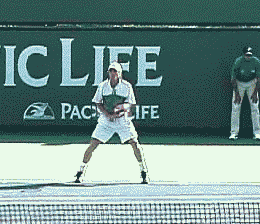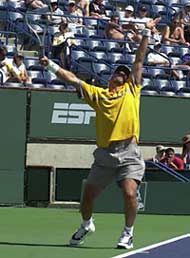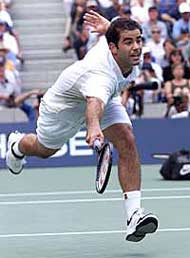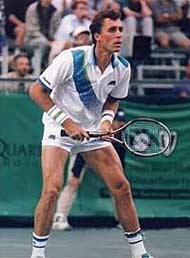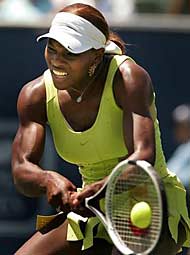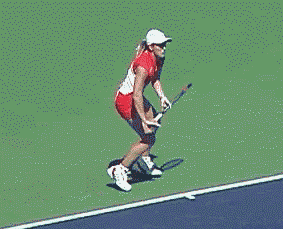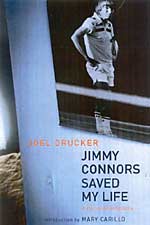|
TennisOne Features
US Open: Last Chance for Love By Joel Drucker
There is a moment in the day when the meaning of the US Open most strikes me. It's not during the arduous Super Saturday when both men's semis and the women's finals are played. Nor is it on that final Sunday when the men's winner holds up the trophy. Nor is it during those raucous evenings, when agitated New York executives come in hopes of witnessing a match that goes past midnight. To me, the US Open's power most strikes between 4 and 7 p.m. These are the late hours of the day, and as befits the late August-early September time of year, these are the moments when the long shadows of summer spread across the court in a rather haunting yet tender fashion. There is a sense during these hours that time is running out, that the season of a sport which follows the sun year-round is now drawing to a close. There is, at these hours, a great sense of urgency, when a top seed might tumble and an unknown might suddenly rumble. And urgency spells drama, which in turn makes the US Open tennis' most compelling and significant tournament. Yes, I believe Wimbledon is great and powerful, and Roland Garros is a hardcore test of fitness and concentration, but it's the US Open where the business of the year is at last settled. It's the final chance to settle scores and make amends, the showdown stage for redemption and salvation.
If time of year has always been a key factor at the Open, since 1978 the event has also been aided by the hardcourt surface. Former British Davis Cupper John Lloyd once put it to me this simply. “The most fit player wins the French – that is, the one who can grind his body through it like Bjorn Borg or their head through it like Chris Evert,” said Lloyd. “The most nimble, athletic player wins Wimbledon – a Pete Sampras or Martina Navratilova. But the best all-around player wins the Open. You can't fake it on that surface. You can't just run down every ball or strike a bunch of good shots. You have to be ready to play offense and defense.” Like America, it is highly democratic. Netrushers like Patrick Rafter and Stefan Edberg have won here. So have baseliners like Ivan Lendl and Mats Wilander. It's also no tournament for dilettantes. In the Open era, only '75 champ Manuel Orantes and '00 winner Marat Safin have failed to add a second Slam title. Other Slams may have their followings, but no Slam is as truly indicative of a player's enduring excellence than the US Open. In recent years, the increasing depth of both tours (particularly the men) has added even more significance to the need for a big finish in New York. This year, for example, five different men and women have won the six Slam titles that have been up for grabs. More importantly, a host of players come to the Open not merely happy to reach the quarters or semis, but are instead in hot pursuit of the title. On the men's side, that includes defending champ Andy Roddick, '01 titlist Lleyton Hewitt and two-time winner ('94, '99) Andre Agassi.
Among women, the Williams sisters are hoping to avoid a Slam shutout for the first time since 1998. Lindsay Davenport – who vaulted to the elite when she won this title six years ago -- is hoping to cap her great summer with a second Open title. And the likes of Justine Henin-Hardenne and Jennifer Capriati will be disappointed with anything less than the big trophy. Russian stars such as French Open winner Anastasia Myskina and Wimbledon champ Maria Sharapova might well be pleased to advance far, but certainly want to be spared the ignominy of an early-round loss. In other words, the Open is the tournament where everyone wants to squeeze out all they can before the tank runs dry. This event's sense of showdown wasn't always so vivid. Prior to the Open era that commenced in 1968, what was then often called “The Nationals” constituted the conclusion of the series of elite tournaments held in clubs all over the Eastern Seaboard. As the late Alan King once told me, “Everyone looked like Rudy Vallee, it was so Old World.” These were the days of shamateurism, when players were paid under-the-table and forgetting to write a thank you note to a member of a host club could drastically sabotage efforts to earn more money in the future. It was a vagabond life. But it was also a charming milieu, where players and spectators were often in close proximity.
Since '68, the Open has become a carnival of commotion and commerce, a fully-realized showcase for the democratic spread of the market economy (which is sometimes good, sometimes bad). One of the biggest sporting events in the world, the Open is a major cultural event attended by many a notable, complete with hours of television coverage and millions in prize money. No other tournament better brings to life the dreams of prior champions like Bill Tilden and Jack Kramer, Pancho Gonzales and Billie Jean King. For so long, they toiled in obscurity, their incredible skills overlooked by a public largely indifferent to what it took to play this incredibly challenging sport. But now, thanks to the US Open, tennis – at least for a few weeks – is a big deal, a 24-hour event where the lights are always shining brightly. But look for me in the shadows. Your comments are welcome. Let us know what you think about Joel Drucker's article by emailing us here at TennisOne .
Jimmy Connors Saved My Life: A Personal Biography Longstanding TennisOne writer Joel Drucker has just published his first book, Jimmy Connors Saved My Life: A Personal Biography. Mr. Drucker provides the most thorough examination ever attempted of one of the most complex characters in recent sports history. The book is both a comprehensive biography of the controversial tennis star and a look at how the author's life intersected and conflicted with Jimbo's. The book includes extensive analysis of Connors' tennis, including the vital impact his mother had as his primary coach, as well as the significant work the great Pancho Segura did in his formative years. Also covered are a great many of Connors' most important matches, as well as many personal interactions Drucker had with Connors that reveal unusual sides to him. |
|||||||||||

